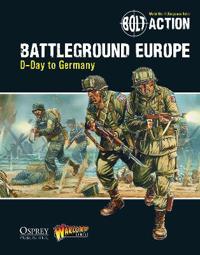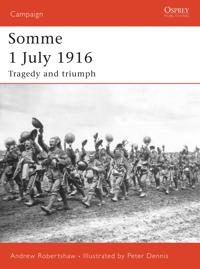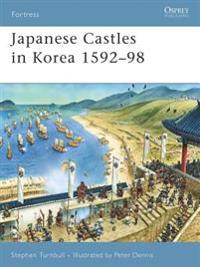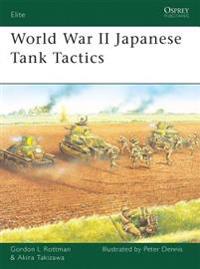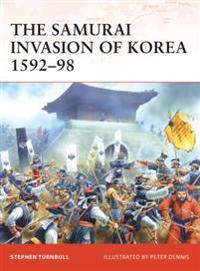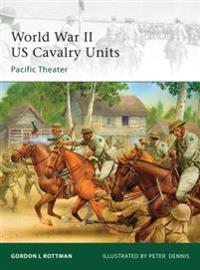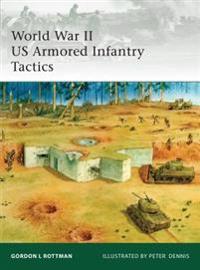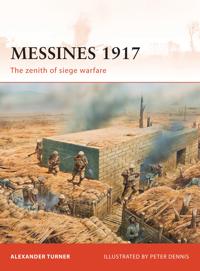Mauser Military Rifles (Pocket)
avNeil Grant, Peter (ILT) Dennis, Neil Grant
ISBN: 9781472805942 - UTGIVEN: 2015-03This volume offers an insight into the iconic Mauser family of German bolt-action rifles. Drawing on first-hand accounts of the weapons in combat and primary sources regarding their mechanical performance, this fully illustrated study charts the Mauser's origins, combat record and lasting influence.[...]
The British Army in Afghanistan 2006-14 (Pocket)
avLeigh Neville, Peter (ILT) Dennis, Leigh Neville
ISBN: 9781472806758 - UTGIVEN: 2015-05Fighting an elusive and dangerous enemy far from home, the British army in Afghanistan has been involved in asymmetric warfare for the best part of a decade. The eight-year series of deployments jointly known as Operation Herrick, alongside US and other NATO contingents within the International Secu[...]
Confederate Cavalryman Vs Union Cavalryman (Pocket)
avRon Field, Peter (ILT) Dennis, Ron Field
ISBN: 9781472807311 - UTGIVEN: 2015-06During the intense, sprawling conflict that was the American Civil War, both Union and Confederate forces fielded substantial numbers of cavalry, which carried out the crucial tasks of reconnaissance, raiding, and conveying messages. The perception was that cavalry's effectiveness on the battlefield[...]
Bolt Action: Battleground Europe (Pocket)
avWarlord Games, Peter (ILT) Dennis, Warlord Games
ISBN: 9781472807380 - UTGIVEN: 2014-11Take the fight to the enemy with this new theatre book for Bolt Action. From the D-Day landings to the final battle for Berlin, this volume gives players everything they need to focus their gaming on these final campaigns in the European Theatre of Operations. Scenarios and special rules offer somet[...]
Ostfront (Pocket)
avWarlord Games, Peter (ILT) Dennis, Warlord Games
ISBN: 9781472807397 - UTGIVEN: 2015-02Take charge of Operation Barbarossa and drive towards Moscow or command the steadfast defenders of the Soviet Union. From the early battles for Leningrad and Sevastopol to the tank clash of Kursk and the bitter urban warfare of Stalingrad, this new Theatre Book for Bolt Action provides wargamers wit[...]
Fighting Sail (Pocket)
avRyan Miller, Peter (ILT) Dennis, Ryan Miller
ISBN: 9781472807700 - UTGIVEN: 2015-05In the years between 1776 and 1815, grand square-rigged sailing ships dominated warfare on the high seas. Fighting Sail is a tabletop wargame of fleet battles in this age of canvas, cannon, and timbers. Players take on the roles of fleet admirals in battles ranging from the American War of Independe[...]
Handbook of Early Intervention for Autism Spectrum Disorders (Inbunden)
avJonathan (EDT) Tarbox, Dennis R. (EDT) Dixon, Peter (EDT) Sturmey
ISBN: 9781493904006 - UTGIVEN: 2014-04Current rates of autism diagnoses have been cause for concern and research as well as rumor and misinformation. Important questions surround the condition: how early can an accurate diagnosis be made? At what age should intervention start? How can parents recognize warning signs? And what causes aut[...]
Alesia 52 BC (Pocket)
avNic Fields, Peter (ILT) Dennis, Nic Fields
ISBN: 9781782009221 - UTGIVEN: 2014-07In 52 BC Caesar's continued strategy of annihilation had engendered a spirit of desperation, which detonated into a revolt of Gallic tribes under the leadership of the charismatic young Arvernian noble Vercingetorix. Major engagements were fought at Noviodunum, Avaricum, and Gergovia, with the last [...]
Mamluk Askar 1250-1517 (Pocket)
avDavid Nicolle, Peter (ILT) Dennis, David Nicolle
ISBN: 9781782009283 - UTGIVEN: 2014-11New archaeological material and research underpins this extensive, detailed and beautifully illustrated account of the famous Mamluk Askars who are credited with finally defeating and expelling the Crusaders, halting the Mongol invasion of the Islamic Middle East, and facing down Tamerlane. Probably[...]
Japanese Castles 1540-1640 (Pocket)
avStephen Turnbull, Peter (ILT) Dennis, Stephen Turnbull
ISBN: 9781841764290 - UTGIVEN: 2003-04The most familiar characteristics of the traditional Japanese castle are the huge sloping stone walls and the graceful yet militarily sophisticated structures built on top of them. This title covers the entire period of Japanese castle development from the first introduction of stone walls and tower[...]
The Walls Of Constantinople Ad 324-1453 (Pocket)
avStephen R. Turnbull, Peter (ILT) Dennis, Stephen R. Turnbull
ISBN: 9781841767598 - UTGIVEN: 2004-11The walls of Constantinople are the greatest surviving example of European medieval military architecture in the world. They withstood numerous sieges until being finally overcome by the artillery of Mehmed the Conqueror in 1453, and exist today as a time capsule of Byzantine and Medieval history. T[...]
Fortifications Of The Western Front, 1914-1918 (Pocket)
avPaddy Griffith, Peter (ILT) Dennis, Paddy Griffith
ISBN: 9781841767604 - UTGIVEN: 2004-10Following the early battles of 1914 along the Marne and in the Ypres salient. World War I rapidly transformed from a war of movement into one of attrition, with the opposing sides entrenching themselves in a line of fortified positions from the Flanders coastline to the Swiss border. This title deta[...]
Japanese Fortified Temples And Monasteries AD 710?1062 (Pocket)
avStephen R. Turnbull, Peter (ILT) Dennis, Stephen R. Turnbull
ISBN: 9781841768267 - UTGIVEN: 2005-08From the 10th century onwards the great monastic foundations of Nara and Mount Hiei maintained large armies of warlike monks, a practice that was later followed by other institutions. The tempestuous political rivalries that developed between the different orders of monks, and even factions within t[...]
Vimy Ridge 1917 (Pocket)
avAlexander Turner, Peter (ILT) Dennis, Alexander Turner
ISBN: 9781841768717 - UTGIVEN: 2005-05In early 1917 Vimy Ridge, one of the most important features on the Western Front, was considered impregnable. However, in a spectacular victory, the four Divisions of the Canadian Army Corps, under Lieutenant-General Sir Julian Byng, took almost the entire ridge in a day. This book examines every a[...]
Anzio 1944 (Pocket)
avSteven J. Zaloga, Peter (ILT) Dennis, Steven J. Zaloga
ISBN: 9781841769134 - UTGIVEN: 2005-08In January 1944, the Allies made the decision to land at Anzio in order to overcome the stalemate at Cassino. The amphibious landing has become one of the most controversial campaigns of World War II. Three months of World War I-style trench warfare was brought on by a series of missteps from the Al[...]
Inch'on 1950 (Pocket)
avGordon L. Rottman, Peter (ILT) Dennis, Gordon L. Rottman
ISBN: 9781841769615 - UTGIVEN: 2006-04Inch'on was probably the most significant campaign in the Korean theater, as well as being the last major amphibious assault of division-size conducted in the history of warfare. The odds were stacked against the US troops, with virtually no time for training and many of the divisions unprepared for[...]
Somme 1 July 1916 (Pocket)
avAndrew Robertshaw, Peter (ILT) Dennis, Andrew Robertshaw
ISBN: 9781846030383 - UTGIVEN: 2006-05Somme is still on record as the largest number of deaths in any one day in any war. This book explores the myths of this infamous battle and explains the underlying causes of the conflict, as well as the use of mines, tunnels, gas and flame throwers by the British in combination with innovative tact[...]
Japanese Castles in Korea 1592-98 (Pocket)
avStephen Turnbull, Peter (ILT) Dennis, Stephen Turnbull
ISBN: 9781846031045 - UTGIVEN: 2007-11The Japanese invasion and occupation of Korea, which lasted from 1592 to 1598, was the only occasion in Japanese history when samurai aggression was turned against a foreign country. During the occupation of Korea the Japanese built 25 wajo or castles. Unlike the castles built in Japan, these fortif[...]
World War II Japanese Tank Tactics (Pocket)
avGordon L. Rottman, Peter (ILT) Dennis, Gordon L. Rottman
ISBN: 9781846032349 - UTGIVEN: 2008-10In this book expert author and tactician Gordon L Rottman provides the first English-language study of Japanese Army and Navy tank units, their tactics and how they were deployed in action. The Japanese army made extensive use of its tanks in the campaigns in China in the 1930s, and it was in these [...]
The Samurai Invasion of Korea 1592-98 (Pocket)
avStephen Turnbull, Peter (ILT) Dennis, Stephen Turnbull
ISBN: 9781846032547 - UTGIVEN: 2008-07The invasions of Korea launched by the dictator Toyotomi Hideyoshi (1592-1593 and 1597-1598) are unique in Japanese history for being the only time that the samurai assaulted a foreign country. Hideyoshi planned to invade and conquer China, ruled at the time by the Ming dynasty, and when the Korean [...]
Amiens 1918 (Pocket)
avAlistair Mccluskey, Peter (ILT) Dennis, Alistair Mccluskey
ISBN: 9781846033032 - UTGIVEN: 2008-06The battle of Amiens was the turning point of World War I, confirming to all that the strategic initiative had decisively returned to the Allies. The battle heralded the arrival of new strategic, tactical and operational methods of attack for the Allies.[...]
Chindit 1942-45 (Pocket)
avTim Moreman, Peter (ILT) Dennis, Tim Moreman
ISBN: 9781846033735 - UTGIVEN: 2009-04The Chindits were a specially organized, equipped and trained body of men employing innovative fighting methods based on ideas originally developed by Major-General Orde Wingate. Raised to fight deep behind Japanese lines in the Burmese Jungle in World War II, their contribution to the Allied cause [...]
World War II U. S. Cavalry Units (Pocket)
avGordon L. Rottman, Peter (ILT) Dennis, Gordon L. Rottman
ISBN: 9781846034510 - UTGIVEN: 2009-10At the time of Pearl Harbor, the United States Army still had ten cavalry regiments. The 26th (Filipino Scouts) fought on horseback in the Philippines, while the rest were fought as infantry. Despite this, the cavalry units maintained their own unique traditions, and identity as they saw action in t[...]
World War II U. S. Armored Infantry Tactics (Pocket)
avGordon L. Rottman, Peter (ILT) Dennis, Gordon L. Rottman
ISBN: 9781846036927 - UTGIVEN: 2009-10Little has been published on US armored infantry units and tactics over the years. However, their contribution to the war effort was hugely important. There were a total of 57 armored infantry battalions and two regiments that served throughout the war and in all theaters. Equipped with halftracks, [...]
Messines 1917 (Pocket)
avAlexander Turner, Peter (ILT) Dennis, Alexander Turner
ISBN: 9781846038457 - UTGIVEN: 2010-08At 0310 hours on 7 June 1917, the pre-dawn gloom on the Western Front was shattered by the 'pillars of fire' - the rapid detonation of 19 huge mines, secreted in tunnels under the German lines and containing 450 tonnes of explosives. Admitted by the Germans to be a 'masterstroke', the devastating bl[...]




